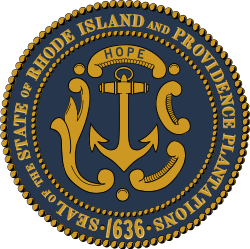History of Providence, Rhode Island
The Rhode Island city of Providence has a nearly 400-year history integral to that of the United States, including significance in the Transatlantic Slave Trade and the American Revolutionary War by providing leadership and fighting strength, quartering troops, and supplying goods to residents by circumventing the blockade of Newport. The city is also noted for the first bloodshed of the American Revolution in the Gaspée Affair. Additionally, Providence is notable for economic shifts, moving from trading to manufacturing; the decline of manufacturing devastated the city during the Great Depression, but the city eventually attained economic recovery through investment of public funds.
Part of a series on the |
|---|
| History of the United States |
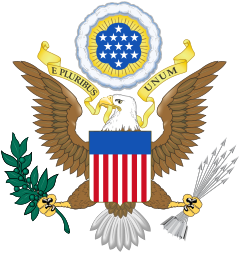 |
|
By ethnicity |
|
|
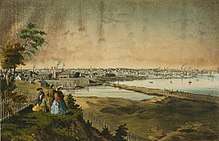
Founding and colonial era
| Part of a series on |
| Baptists |
|---|
 |
|
Background |
|
Organizations
|

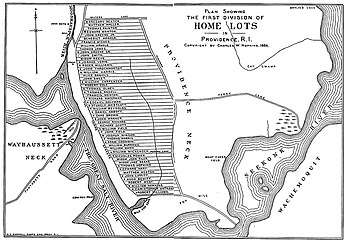
Providence was settled in June 1636 by Roger Williams and others who had been banished from Massachusetts Bay Colony over religious disagreements. It grew into one of the Thirteen Colonies, and was the first to declare independence from England prior to the American Revolutionary War.[1]
... all civil states with their officers of justice in their respective constitutions and administrations are proved essentially civil, and therefore not judges, governors, or defenders of the spiritual or Christian state and worship.
- — Roger Williams, A Plea for Religious Liberty[2]
Williams secured a title from the Narragansett Indians around this time and named the settlement Providence Plantations, cultivating it as a refuge for religious dissenters, as he himself had been exiled from Massachusetts Bay.[3] Providence Plantation was an agricultural and fishing community, though its lands were difficult to farm and its borders were disputed with Connecticut and Massachusetts.[3] An Indian coalition burned Providence to the ground on March 29, 1676, during King Philip's War, one of two major Colonial settlements burned.[4]
After the town was rebuilt, the economy expanded into more industrial and commercial activity. The outer lands of Providence Plantation extending to the Massachusetts and Connecticut borders were incorporated as Scituate, Glocester, and Smithfield, Rhode Island, in 1731.[3] Later, Cranston, Johnston, and North Providence were also carved out of Providence's municipal territory.[3] By the 1760s, the population of the remaining urban core reached 4,000.[3]
American Revolution

In the mid-1770s, the British government levied taxes that impeded Providence's maritime, fishing, and agricultural industries, the mainstays of the city's economy. One example was the Sugar Act, which affected Providence's distilleries and its trade in rum. These taxes caused the Colony of Rhode Island to join the other colonies in renouncing allegiance to the British Crown. Providence residents were among the first to spill blood in the American Revolution during the Gaspée Affair in 1772.[3]

The city escaped enemy occupation during the American Revolutionary War, but the British captured Newport, which disrupted industry and kept the population on alert. American troops were quartered in Providence for various campaigns, and Brown University's University Hall was used as a barracks and military hospital.[3] French troops were quartered in the city's Market House.[5]
Following the war, the economy shifted from maritime endeavors to manufacturing, particularly machinery, tools, silverware, jewelry, and textiles. At one time, Providence boasted some of the largest manufacturing plants in the country, including Brown & Sharpe, Nicholson File, and Gorham Manufacturing Company.[3] The city's industries attracted many immigrants from Ireland, Germany, Sweden, England, Italy, Portugal, Cape Verde, and French Canada. Economic and demographic shifts caused social strife.[3] Hard Scrabble and Snow Town were two African American neighborhoods and were the sites of two riots in 1824 and 1831.[6][7] Providence residents ratified a city charter in 1831 as the population passed 17,000.[3]
City Government
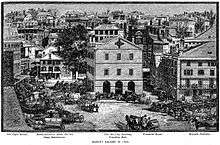
The seat of city government was located in the Market House from its incorporation as a city in 1832 until 1878.[8] Market House is located in Market Square, which was the geographic and social center of the city. The city offices quickly outgrew this building, and the City Council resolved to create a permanent municipal building in 1845.[8] The city spent the next 30 years searching for a suitable location, resulting in what one historian calls "Providence's Thirty Years War," as the council bickered over where to situate the new building.[8] The city offices moved into the Providence City Hall in 1878.
Jewelry Industry

Seril Dodge and his nephew Nehemiah Dodge started the manufacture of jewelry in Providence in 1794, and jewelry was once the primary industry in Rhode Island.[9][10] The industry grew slowly during the early 19th century, then more rapidly.[11] Jewelry making and silverware attracted both American and foreign craftsmen to the city as the industry grew in prominence.[11] By 1850, there were 57 firms and 590 workers in the jewelry trade.[11] By 1880, Rhode Island led the United States in the manufacture of jewelry, accounting for more than one quarter of the entire national jewelry production.[11] By 1890, there were more than 200 firms with almost 7,000 workers in Providence.[10]
By the 1960s, jewelry trade magazines referred to Providence as “the jewelry capital of the world.”[10] The industry peaked in 1978 with 32,500 workers, then began a swift decline.[9] By 1996, the number of jewelry workers shrank to 13,500.[9] Numerous former factories were left vacant in the jewelry district, and many of them became offices, residences, restaurants, bars, and nightclubs.[9]
Expansion and wealth

Providence thrived in the late 1800s, with waves of immigrants bringing the population from 54,595 in 1865 to 175,597 by 1900.[3] By 1890, Providence's Union Railroad had a network which included over 300 horsecars and 1,515 horses.[13] Two years later, the first electric streetcars were introduced in Providence,[13] and the city soon had an electric streetcar network extending from Crescent Park to Pawtuxet in the south and Pawtucket in the north.[13] According to journalist Mike Stanton, "Providence was one of the richest cities in America in the early 1900s."[14]
However, increased population density brought public health problems when a cholera outbreak swept the city in 1854. A survey of living conditions conducted by the city discovered unhealthy crowding among immigrants and workers. In one case, 29 people were recorded as living in a single-story house; in another, 47 people shared a two-story home. The survey found 5,780 outhouses in the city, of which "fewer than half were emptied annually." Local cemeteries saw record numbers of burials. For the next 30 years, 1854 was remembered as "The Year of Cholera".[15]
Influenza outbreak
In early September 1918, the first cases of the Spanish flu started appearing in Providence.[16] By the end of the month, public health superintendent Charles V. Chapin had identified over 2,500 cases in the city.[16] Chapin and other officials responded by ordering more hospital beds and increased staffing.[16] On October 6, the Providence Board of Health issued a general closure order, affecting all public and private schools, theaters, movie houses, and dance halls.[16] The spread of the influenza reached its highest level during October 3–9, with 6,700 cases reported.[16] The closure order was rescinded on October 25.[16] The flu returned for a smaller second wave in January 1919, which hit schools particularly hard.[16] By February 5, no new cases were being reported and the pandemic was declared over.[16]
Decline
_(14779464262).jpg)
The city began to see a decline by the mid-1920s as industries shut down, notably textiles. The Great Depression hit the city hard, and Providence's downtown was flooded by the New England Hurricane of 1938 soon after. The city saw a further decline as a result of the nationwide trends with the construction of highways and increased suburbanization.[3] From the 1950s to the 1980s, Providence was a notorious bastion of organized crime. Legendary mafia boss Raymond L.S. Patriarca ruled a vast criminal enterprise from the city for over three decades, during which murders and kidnappings became commonplace.[17]
21st century
The city's experienced a sort of Renaissance in the late 1970s and early 1980s, as $606 million of local and national Community Development funds was invested throughout the city and the declining population began to stabilize. In the 1990s, Mayor Buddy Cianci showcased the city's strength in arts and pushed for further revitalization, ultimately resulting in opening up the city's rivers (which had been paved over), relocation of a large section of railroad underground, creation of Waterplace Park and river walks along the river's banks, and construction of the Fleet Skating Rink (now the Bank of America Skating Rink) in downtown and the 1.4 million ft2 Providence Place Mall.[3]
New investment was triggered within the city with new construction filling in the freed space, including numerous condominium and hotel projects and a new office highrise.[18][19]
Poverty remains a problem. Nearly 30% of the city population lives below the poverty line,[20] and Providence had the highest rise in median housing price of any city in the United States from 2004 to 2005.[21] The city has begun planning on how to incorporate all projects in a way that promotes future development and capitalizes on the historic nature of the city and waterfront land.[22] Emphasis has been placed on the following:
- $20 million "Enhanced Bus Circulator" with traffic-light priority and special stations[23]
- Redevelopment of centrally located land freed up by the relocation of Interstate 195
- Riverfront improvements on the Woonasquatucket River west of Providence Place, creating pedestrian access to the waterfront
- Redevelopment of the corridor south of Downcity between the Providence River and Interstate 95.
Bicycle and pedestrian initiatives
The late 2010s saw a number of bicycle and pedestrian infrastructure improvements, many spearheaded by Jorge Elorza, himself a cycling enthusiast.[24] A greenway opened in Roger Williams Park in 2017.[24] In August 2019, a pedestrian bridge spanning the Providence River, and connecting the east and west sides of downtown, opened.[25] It was built on the granite piers of the old Route 195 bridge.[25] A bicycle sharing program started in September 2018, only to be halted within a year due to vandalism and theft.[26]
In January 2020, mayor Jorge Elorza unveiled a "Great Streets" initiative to create a framework of public space improvements to encourage walking, riding bicycles, and public transit.[27] The plan includes establishing an "Urban Trail Network" which includes 60 miles of bicycle paths, bike lanes, and greenways within Providence.[28]
See also
- Timeline of Providence, Rhode Island
- List of newspapers in Rhode Island in the 18th century: Providence
Notes
- "Roger Williams". nndb.com. Soylent Communications. Retrieved 2007-06-09.
- "A Plea for Religious Liberty".
- "Three and One-Half Centuries at a Glance". City of Providence, Rhode Island. May 2002. Retrieved 2006-01-17.
- Lepore, xxvii.
- Cady, John Hutchins (October 1952). "The Providence Market House and its neighborhood" (PDF). Rhode Island History. Rhode Island Historical Society. 11 (4): 97–106. Retrieved 9 April 2015.
- "Hardscrabble". Brown University. Archived from the original on 2011-07-17. Retrieved 2010-08-02.
- "Snow Town Riot". Brown University. Archived from the original on 2011-07-17. Retrieved 2010-08-02.
- Campbell, Paul. "A Brief History of Providence City Hall". City Archives. City of Providence. Retrieved 10 April 2015.
- Abbott, Elizabeth (26 January 1997). "Providence Jewelry District Gets a New Luster". The New York Times. Retrieved 27 July 2016.
- Davis, Paul (4 July 2015). "R.I.'s jewelry industry history in search of a permanent home". Providence: The Providence Journal. Retrieved 27 July 2016.
In 1794, Seril Dodge opened a jewelry store on North Main Street in Providence, and Nehemiah Dodge developed a process for coating lesser metals with gold and silver. Historians say that the two men started Rhode Island’s jewelry industry.
- "The History of the Jewelry District". Historic Jewelry District. Providence: The Jewelry District Association. Retrieved 27 July 2016.
In 1830, there were 27 jewelry firms employing 280 workers in Providence; by 1850, there were 57 firms and 590 workers.
- Arnold, Horace L. "Modern Machine-Shop Economics. Part II" in Engineering Magazine 11. 1896
- Molloy, Scott (2007). Trolley Wars: Streetcar Workers on the Line. UPNE. pp. 65–66. ISBN 978-1584656302. Retrieved 31 May 2015.
- Stanton, Mike (2003). The Prince of Providence. New York: Random House. p. 7. ISBN 0-375-75967-0.
- McKenna, Ray (19 April 2020). "My Turn: Ray McKenna: R.I. residents of 1854 would relate". The Providence Journal. Retrieved 20 April 2020.
- "Providence, Rhode Island". Influenza Encyclopedia. University of Michigan Center for the History of Medicine and Michigan Publishing, University of Michigan Library. Retrieved 6 June 2020.
- "CHAPTER ONE: DIVINE PROVIDENCE". CRIMETOWN. Retrieved 2018-07-20.
- Lynn Arditi. "Condo supplies risings as prices drop". projo.com. Providence Journal. Retrieved 2007-06-09.
- Daniel Barbarisi. "Hunger for Hotels". projo.com. Providence Journal. Retrieved 2007-06-09.
- "Providence City, Rhode Island". census.gov. US Census Bureau. Archived from the original on 2020-02-12. Retrieved 2007-06-09.
- "Money Magazine: Best Places to Live: Home Appreciation". cnnmoney.com. Cable News Network LP, LLLP. Retrieved 2007-03-06.
- "Providence 2020" (PDF). Archived from the original (PDF) on 2007-07-04. Retrieved 2007-01-15.
- Anderson, Patrick (6 January 2016). "Providence abandons streetcar plan for new bus line". The Providence Journal. Retrieved 27 July 2016.
- Curley, Bob (22 June 2017). "Building a More Bikeable Providence". Rhody Beat. Archived from the original on 22 May 2020. Retrieved 22 May 2020.
- List, Madeline (9 August 2019). "$21.9 million later, pedestrian bridge opens in downtown Providence". The Providence Journal. Retrieved 29 August 2019.
- Amaral, Brian (20 May 2020). "Watchdog Team: Company behind Jump bikes was stunned by level of vandalism in Providence". The Providence Journal. Archived from the original on 21 May 2020. Retrieved 21 May 2020.
- "City of Providence Unveils Final Great Streets Plan". City of Providence. City of Providence. Retrieved 21 May 2020.
- "Providence Unveils Plan for 'Great Streets'". Eco RI News. 29 January 2020. Archived from the original on 13 May 2020. Retrieved 21 May 2020.
- 4. Three and One-Half Centuries at a Glance ProvidenceRI.com - History and Fact.
References
- Lepore, Jill. (1998). The Name of War: King Philip's War and the Origins of American Identity. New York: Vintage Books. ISBN 0-375-70262-8.
Further reading
- The early records of the town of Providence, Internet Archive
